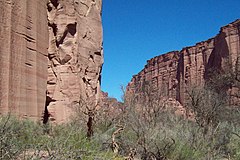| Tarjados Formation | |
|---|---|
| Stratigraphic range: Early-Mid Triassic ~252–236 Ma PreꞒ Ꞓ O S D C P T J K Pg N | |
 Sandstones in Talampaya National Park Sandstones in Talampaya National Park | |
| Type | Geological formation |
| Unit of | Paganzo Group |
| Underlies | Chañares Formation |
| Overlies | Talampaya Formation |
| Thickness | Up to 250 m (820 ft) |
| Lithology | |
| Primary | Sandstone |
| Other | Conglomerate |
| Location | |
| Coordinates | 29°48′S 67°48′W / 29.8°S 67.8°W / -29.8; -67.8 |
| Approximate paleocoordinates | 48°00′S 38°54′W / 48.0°S 38.9°W / -48.0; -38.9 |
| Region | La Rioja Province |
| Country | |
| Extent | Ischigualasto-Villa Unión Basin |
| Type section | |
| Named for | Sierra de Los Tarjados |
| Named by | Romer & Jensen |
| Year defined | 1966 |
 | |
The Tarjados Formation is an Early to Middle Triassic geologic formation in the Ischigualasto-Villa Unión Basin of La Rioja Province in northwestern Argentina. The red to whitish sandstones and conglomerates of the formation were deposited in an arid fluvial environment. The formation overlies the Talampaya Formation and is overlain by the Chañares Formation of the Agua de la Peña Group.
The formation has provided fossils of an archosaur and a kannemeyeriid dicynodont, both not yet placed in a dedicated genus. The formation crops out in the Talampaya National Park, which was designated a UNESCO World Heritage Site in 2000.
Description
The formation was first defined by Romer and Jensen in 1966, based on a type section exposed in the Sierra de Los Tarjados. The Tarjados Formation, as the underlying Talampaya Formation, belongs to the Paganzo Group.
The formation is exposed in the Talampaya National Park of La Rioja Province. The Tarjados Formation is overlain by the Chañares Formation, separated by a regional unconformity.
The formation, reaching a maximum thickness of 250 metres (820 ft), comprises red to greenish grey sandstones, deposited in an eolian and playa-lacustrine to fluvial environment. The sediments were deposited under arid, or semi-arid conditions.
The formation has provided fossils of an archosaur and a kannemeyeriid dicynodont, both not yet placed in a dedicated genus.
See also
- Santa Maria Formation, contemporaneous fossiliferous formation of the Paraná Basin in southeastern Brazil
- Katberg Formation, contemporaneous fossiliferous formation of the Karoo Basin in South Africa
- Fremouw Formation, contemporaneous fossiliferous formation of Antarctica
References
- Talampaya National Park at Fossilworks.org
- Caselli, 1998, p.22
- Balabusic et al., 2001, p.14
- Tarjados Formation at Fossilworks.org
- Balabusic et al., 2001, p.26
- Aceituno Cieri et al., 2015, p.60
- Monetta et al., 2000, p.648
- Monetta et al., 2000, p.644
- ^ Ezcurra et al., 2015, p.476
- Balabusic et al., 2001, p.28
- Ezcurra et al., 2015, p.478
- Ezcurra et al., 2015, p.479
Bibliography
- Aceituno Cieri, P.; Zeballos, M.E.; Rocca, R.J.; Martino, R.D.; Carignano, C.; Guereschi, A.; Giambastiani, M. (2015), "Condicionantes geológicos en el cruce de la sierra de Valle Fértil. San Juan - Geological constraints at the crossing of sierra Valle Fertil. San Juan", Revista de Geología Aplicada a la Ingeniería y al Ambiente, 35: 57–69
- Balabusic, Ana M. (2001), Plan de Manejo del Parque Nacional Talampaya (PDF), Administración de Parques Nacionales, pp. 1–68, retrieved 2019-03-28
- Caselli, Alberto Tomás (1998), Estratigrafía y sedimentología de las formaciones Patquía (Pérmico) y Talampaya (Triásico Inferior), en las Sierras Pampeanas Noroccidentales y Precordillera Central (Provincias de La Rioja y San Juan) (PhD thesis) (PDF), Universidad de Buenos Aires, pp. 1–437, retrieved 2019-03-28
- Ezcurra, Martín D.; Martinelli, Agustín G.; Fiorelli, Lucas E.; Da Rosa, Attila A.S.; Desojo, Julia B. (2015), "Archosauromorph remains from the Tarjados Formation (Early-Middle Triassic, NW Argentina)", Ameghiniana, 52 (5): 475–486, doi:10.5710/AMGH.12.05.2015.2907, hdl:11336/12108, retrieved 2019-03-28
- Monetta, A.; Baraldo, J.; Cardinali, A.; Weidmann, R.; Lanzilotti, M. (2000), Distribución y características del magmatismo intratriasico de Ischigualasto, San Juan, Argentina (PDF), IX Congreso Geológico Chileno, pp. 644–648, archived from the original (PDF) on 2019-03-28, retrieved 2019-03-28
Further reading
- Bonaparte, J.F (1978), "El Mesozóico de América de Sur y sus Tetrapodos - The Mesozoic of South America and its tetrapods", Opera Lilloana, 26: 1–596
- Geologic formations of Argentina
- Triassic System of South America
- Early Triassic South America
- Middle Triassic South America
- Triassic Argentina
- Anisian Stage
- Ladinian Stage
- Olenekian Stage
- Sandstone formations
- Conglomerate formations
- Aeolian deposits
- Fluvial deposits
- Lacustrine deposits
- Ischigualasto-Villa Unión Basin
- Fossiliferous stratigraphic units of South America
- Paleontology in Argentina
- Geology of La Rioja Province, Argentina